Retail (SILVER)
Building Brand Equity (GOLD)
Long Term Success (SILVER)
Client Credits: Canadian Tire
Sr. Vice President CTC Marketing: Susan O’Brien
Vice President Strategic Marketing: Eva Salem
AVP Brand Marketing: Cindy Graham
Specialist, Strategic Marketing: Letitzia Serbanescu
Manager, Brand Marketing, Innovation: Jonathan Anderson
Associate Marketing Manager, Innovation: Andrée Dillon
Marketing Specialist, Innovation: Meg Wilson
Manager of Innovation, Strategic Marketing: Misha Lobo
Associate Marketing Manager, Innovation: Karen Richardson
Specialist Marketing operations, Innovation: Karolina Deoniziak
Agency Credits: TAXI
Chief Creative Officer: Jordan Doucette
Creative Director: Tom Greco
Associate Creative Director: Colin Brown
Associate Creative Director: Dave Luxton
General Manager: Scott Beffort
Managing Director: Michael Strasser
Account Director: Natalie Street
Account Director: Adam Ball
Account Supervisor: Julian Morgan
Section I — CASE PARAMETERS
| Business Results Period (Consecutive Months): | June 2013 – Current |
| Start of Advertising/Communication Effort: | June 2013 |
| Base Period as a Benchmark: | 2010-13 brand Health; 2013 & subsequent YOY sales |
| Geographic Area: | National, English and French |
| Budget for this effort: | Over $5 million |
Section IA — CASE OVERVIEW
Why should this case win in the category (ies) you have entered?
Fighting a battle on one front is tough. Fighting it on two really shows what you’re made of.
In 2013, Canadian Tire faced two distinctly different but equally concerning business challenges. Internally, key brand and business drivers showed signs of softness after several years of stability. Externally, the pending arrival of US-retailer Target was an undeniable cause for concern. The response that was developed to address this situation head on, “Tested for Life in Canada,” has helped the company weather competitive challenges, and has become a unique brand asset, differentiator and growth driver.
In order to stake Canadian Tire’s unique role in the Canadian retail landscape, we developed a business idea that demonstrated the quality and relevance of its products. This resulted in the development of a unique brand asset that has driven five years of growth and transformed the way the company goes to market, as measured by product sales, brand differentiation and brand health.
Key to our success was demonstrating the tangible way in which the retailer understands and meets the needs of Canadians, which distinguished itself from its diverse and aggressive competitive set.
“Tested for Life in Canada” has achieved success on several levels.
Building Brand Equity
“Tested” is proof a strong idea can do more than just sell products. It can change perceptions of the company offering them, and in really exceptional cases, change the way the company itself does business.
Retail
Some ideas build brand equity. “Tested” has undeniably done that, but it has also quantifiably driven sales results.
Long-term Success
Five years after the launch of “Tested,” the idea continues to grow. In a category prone to short-term tactics, it has proven to be a long-lasting initiative with the ability to grow in its strategic importance to the brand.
Section II — THE CLIENT’s BUSINESS ISSUES/OPPORTUNITIES
a) Describe the Client’s business, competition and relevant history:
To anyone other than a Canadian, Canadian Tire doesn’t make much sense. No other retailer in the world sells car parts right beside small kitchen appliances, or offers Christmas decorations and fishing tackle. Yet to those who call Canada home, it’s the go-to store for a surprisingly large number of our everyday needs. Its business comprises four areas: living (homewares and décor), driving (automotive service and parts), fixing (tools) and playing (sports and recreation).
For decades, Canadian Tire’s competition was exclusively Canadian. This changed in 1994 with arrival of Walmart and Home Depot. The entry of these major American brands was a turning point in Canadian retail. Similarly, when Lowe’s arrived in 2007, many Canadian retailers felt the impact of yet another US entrant.
In 2013, the imminent arrival of Target was a major story in Canadian business. Target had something Home Depot and Walmart lacked: cachet. It was famous in the US for collections produced in collaboration with fashion and décor designers. Ad campaigns had the quality of upmarket fashion brands. “Tarjay,” as devoted followers called it, offered the impossible: low prices combined with great design. As a destination for cross-border shopping, many Canadians knew the brand long before it opened its doors here.
Target was undeniably a serious threat, but it was not Canadian Tire’s only concern. For years the retailer introduced products featuring innovations not available anywhere else, but just as Target was about to come into Canada, overall trust and innovation perceptions as well as their core equity metric “equips me for the jobs and joys of life in Canada” were beginning to slide. 2013 was shaping up as a year with two very significant business challenges.
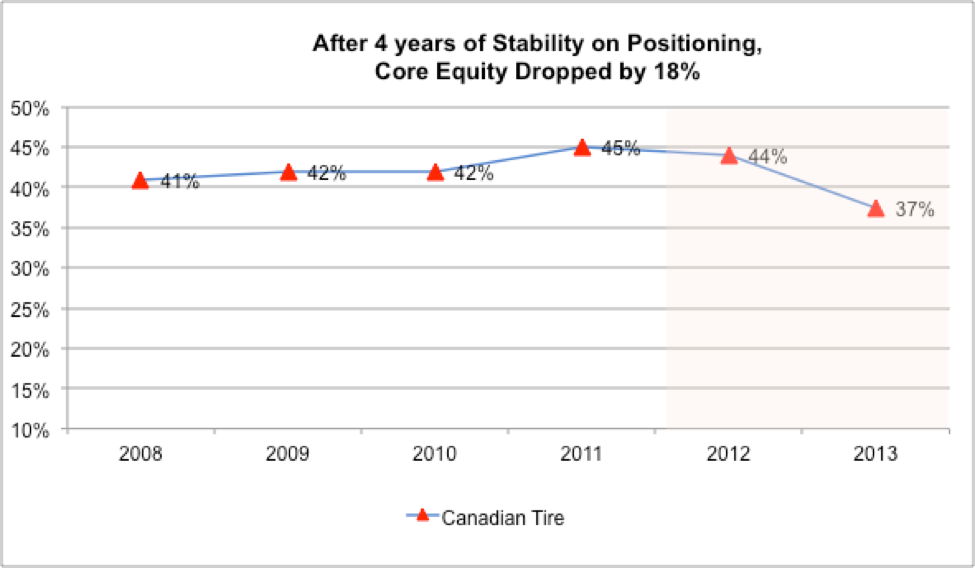
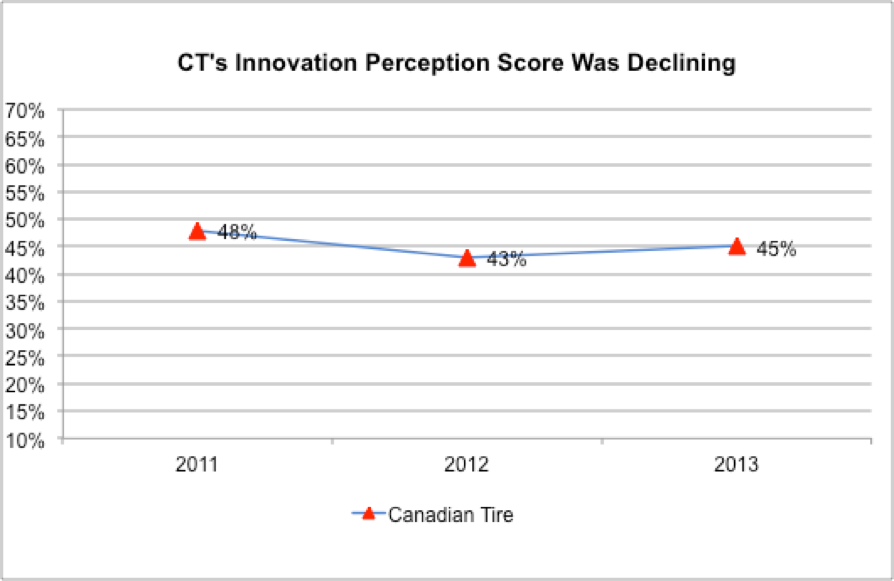
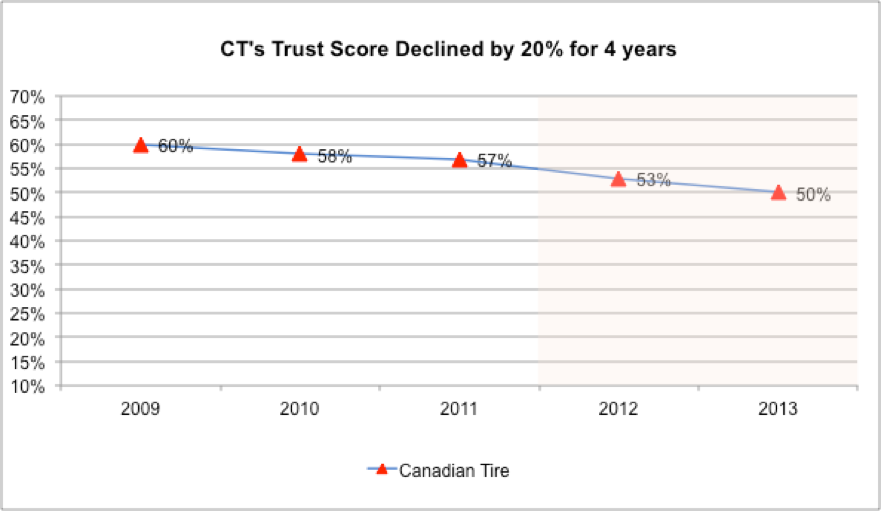
b) Describe the Client’s Business Issues/Opportunities to be addressed by the campaign:
Canadian Tire faced a scenario unlike anything it had experienced before. Target was a tangible business threat in itself and because of the response it would unleash from existing competitors who would unquestionably intensify their competitive efforts.
Two of Canadian Tire’s long-standing benefits – familiarity and convenience – would not win the day on their own. 90% of Canadians live within 15 minutes of a store, but the brand needed more than proximity and established shopping habits to compete. Pricing would not be a strategy – there was no desire to create a race to the bottom. Upping design credentials was a possibility, but would not tap into the core of Canadian Tire’s essence.
The imminent competitive environment required us to overtly assert the role Canadian Tire is uniquely qualified to play in the Canadian retail landscape. The positive emotion the brand earned over the years had to be supplemented with a compelling proof point to build differentiation and ground trust in a unique, relevant and credible way.
We had to look into the very core of the brand and articulate its reason for being in an undeniably Canadian way, to give consumers a new reason to believe in a store they’d been going to forever, and firmly establish that no retailer understands life in Canada like Canadian Tire.
c) Resulting Business Objectives: Include how these will be measured:
The most important metrics in this battle would demonstrate that Canadian Tire understands life in Canada, and has the products to prove it. The brand’s long-term positioning has been “equipping families for the jobs and joys of life in Canada”, and Target’s arrival wasn’t going to change that. Our primary metrics were measures already in place:
- CT understands the needs of Canadians better than other retailers.
- CT makes the jobs and joys of life in Canada easier
These two measures would indicate if the brand was holding its own in the face of competition. Brand-health attributes that would be important to defend and grow would be:
- CT offers innovative products
- CT is a trusted brand
- CT offers quality products
Sales goals were – and continue to be – set for individual products. Examples of this throughout the years are:
- 2015 Thompson’s WaterSeal Waterproofing Stain +10%
- 2015 Continental All-Season Tires +20%
- 2016 Insta Mop +30%
- 2016 Yardworks Dry Seal Hose +50%
Section III — YOUR STRATEGIC THINKING
a) What new learnings/insights did you uncover?
We weren’t going to let a competitor distract us from our positioning of equipping families for the jobs and joys of life in Canada, or from the task of improving innovation and quality scores. The question became how exactly we’d do that.
In research, we heard consumers’ excitement about Target’s imminent arrival. We also heard, perhaps more than we wanted to, an undercurrent of “Crappy Tire.” People let us know not everything on the shelves was as good as it should be. They were disappointed and expected better, reinforcing what tracking indicated. Interestingly, however, despite consumers’ disappointments, one of the most compelling things we heard was that deep down, a lot of people really wanted to see Canadian Tire win.
An undercurrent started to emerge in research that counterbalanced people’s intrigue about Target’s arrival: they were also hoping “Canada’s Store” would stand up to intense competition. When we dug deeper and asked why, we realized the answers coming back were all emotional. We heard things like, “I went there with my dad when I was a kid” or “I’d like to see a Canadian company hold its own.” We also realized what we weren’t hearing, that Canadian Tire had the products Canadians really need. When we probed deeper, people told us “yes of course, Canadian Tire carries these items,” but the association wasn’t spontaneous or assertive.
Ultimately, three things became clear. First, we didn’t need an ad campaign, but a business idea that went right to Canadian Tire’s roots and to products that earned trust by delivering what’s needed for life in this country. Second, the emotional bond to Canadian Tire’s brand had to be complimented with a rational appreciation for its products. Third, not all products had been up to customers’ standards. If we wanted to win, we needed a compelling way to prove Canadian Tire, more than any other retailer, uniquely understands what Canadians need for life in Canada.
Insight
The best way to know if a product meets the needs of life in Canada is to have Canadians test it.
Why is this relevant?
Asking Canadians to test our products and tell us what they thought of them, demonstrated a sincere intent to meet their needs. The Tested program identified products that really did stand up to life in Canada, and just as importantly, those that didn’t. Asking Canadians for input involved them in a way no other retailer had, and demonstrated the company valued customer satisfaction, not just sales.
The brand’s heritage is in practical items that are part of day-to-day life. Testing items Canadians could relate to would reinforce relevance. Credibility would come from the connection of decades of selling products just like those being tested.
The confidence that would be created in the company’s products would counterbalance Target’s cachet. Style is a consideration in many product categories, but most Canadian Tire products are purchased for their ability to do the practical jobs.
b) What was your Big Idea?
To prove Canadian Tire understands Canada better than other retailers, we engaged Canadians – regular people and category experts like contractors – to put our products to the test. Products that stand up to the task are awarded the “Tested for Life in Canada” badge/designation.
c) How did your Communication strategy evolve?
Tracking indicators and the insight made the brief very clear: put Canadian Tire’s products in the hands of customers and ask their opinion once they had tried them out. Key principles in the brief were:
Objectivity: Canadian Tire could tell you about their products – or someone who looked an awful lot like your neighbour could. The objectivity of regular people would be persuasive.
Tangible innovation: The decline in innovation-tracking scores indicated all featured products had to be more than reliable, they had to offer relevant new features or benefits to customers. If we were able to deliver on this, we believed we could also increase quality credentials.
Range: “Life in Canada” requires a range of products. We needed an idea that would readily accommodate products spanning the Living/Driving/Fixing/Playing spectrum and that could create a cohesion across the unique range found nowhere else on earth but Canadian Tire.
d) How did you anticipate the communication would achieve the Business Objectives?
The power of a business idea like Tested is its ability to demonstrate the suitability and reliability of Canadian Tire’s products for Canadian life. Asking customers to evaluate product performance meant we were asking the experts, the people who know what it takes to live in Canada because they do it every day. Using a small subset of customers to vet products for the rest of Canada made sure we were staking our reputation on the items that would reinforce the right things about the brand.
Our objective was to be acknowledged as the retailer who best understood life in Canada. Tested forced us to prove it. It also supplemented the positive emotion the brand had earned over the years with a compelling, credible proof point to build differentiation and trust.
Section IV — THE WORK
a) How, where and when did you execute it?
Tested has had five waves of support, growing in scale each year. By 2017, it became the core focus of all communication activities. Below is an overview of its stages:
2013/2014 Introduction: Products addressing the extremes of climate faced in Canada (e.g., windshield wipers that deal with ice, tires suited for heavy rain) were the core of the campaign. Included in this phase was the Ice Truck: a working truck with a body built entirely of ice that tested the MotoMaster Eliminator battery’s performance in -40 degree temperatures.
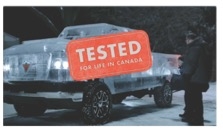

2015/2016 A Bigger Story: The year began with communication telling the story of how products were tested (with real people, not in labs). This established the understanding that over 15,000 Canadians were responsible for the testing. Product spots ran for the rest of the campaign.


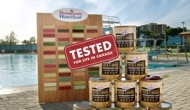


2017: Introducing Testers: The most recent work profiles individual testers and the products they vet.






Tested has been applied as a badge on products in-store. It also has a significant presence online, where all Tested products are featured.

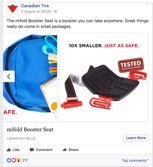
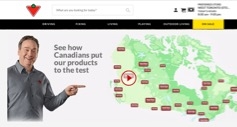
c) Media Plan Summary
Section V — THE RESULTS
a) How did the work impact attitudes and behaviour?
What started as an idea in a creative presentation transformed how Canadian Tire operates as a company. The organization has restructured processes around sourcing products that meet the standards of Tested. It has ended relationships with some suppliers and initiated business with others who can deliver the quality Canadian Tire requires. Ironically, while Target’s presence in Canada was surprisingly short-lived, Tested has become an equity that is now central to plans for the future.
Five years in, the consumer impact of Tested is undeniable. Awareness has grown steadily since launch (see Fusion Analytics chart in Section VI) and among Canadians aware of Tested, the three key brand-health scores – trust, innovation and quality – have grown significantly:
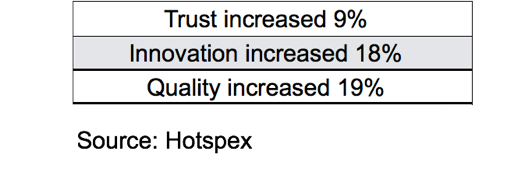
At the highest level of the business, Tested has reinforced Canadian Tire as the retailer that best understands life in Canada, with the majority of Canadians agreeing with this. To top it off, our core brand-equity metric “equips me for the jobs and joys of life in Canada” has increased by 14 points from 2013.
Source: Fusion Analytics
Consumer behaviour online further demonstrates the impact of Tested. A recent evaluation of web sales show Tested products have:

b) What Business Results did the work achieve for the client?
Program level
Starting as an endorsement for a small assortment of products, the Tested program has expanded to permeate virtually every line of business. The most recent sales figures available from CT’s internal sales analytics (a 2017 year-over-year analysis of POS$ from March to May) confirm that Tested products sold 18% more than non-Tested products in-store POS$ vs. non-Tested products.
Product/category level
A sampling of products from 2013 to 2017 shows how Tested lifts sales for specific products featured as well as for the larger category that product represents. Crucially, Tested sales do not come at the expense of other products.
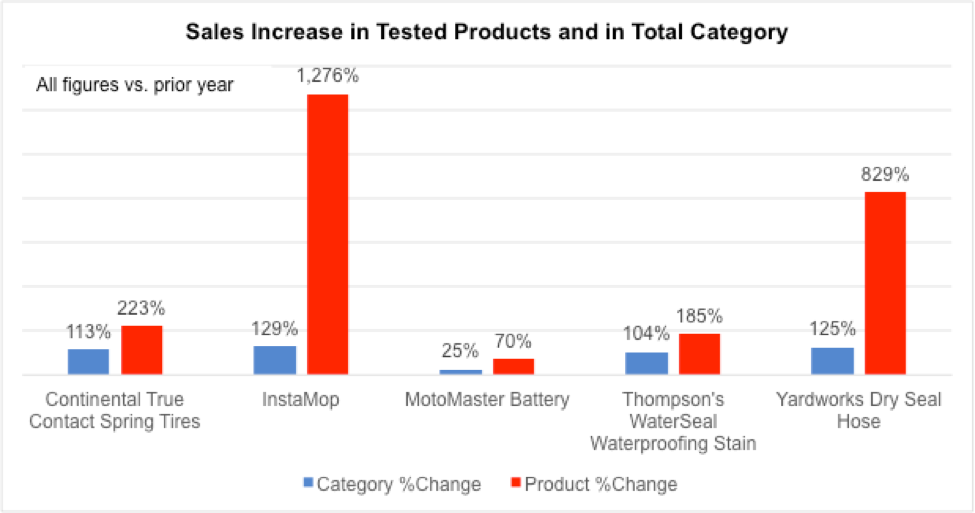
Seasonal level
Catalogues are published throughout the year, which are typically either seasonal or category (e.g., home or auto) focused, containing a mix of Tested and non-Tested products. The most recent results show Tested’s impact:
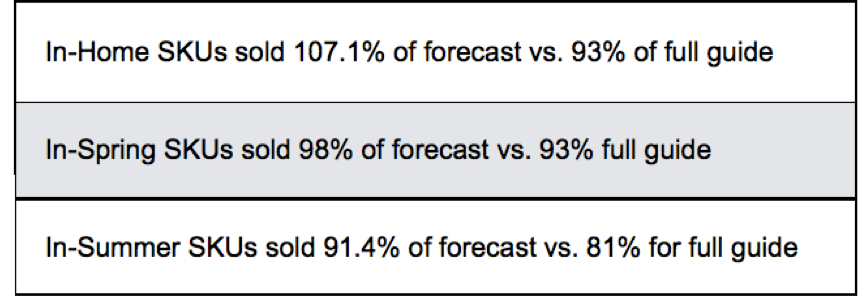
c) Other Pertinent Results
A recent Globe and Mail article speaks to the power of Tested:

Additionally, the 2017 Leger National Corporate Reputation Study recognized Canadian Tire as:
- Canada’s Most Admired Department Store/Mass Merchandiser
- #3 Overall Most Admired Company, 6 points behind #1 Google
Why is this important? Because 87% of the Leger ranking is made up by Canadians’ positive impressions on two metrics:
- Quality of Products and Services
- Honesty and Transparency
This continues Canadian Tire’s trend of rising up the charts, starting at #8 in 2012, hitting #4 in 2016 and reaching the podium in 2017.
d) What was the campaign’s Return on Investment?
Traditional ROI is based on the relationship between media investment and sales lift. The investment in Tested permeates the corporation in ways that can’t be quantified into areas such as product development, training, and customer relations. While no calculation captures this, the most telling indicator of Tested’s ROI is the commitment Canadian Tire has made to the program. In its 2016 annual report, the continued expansion of Tested for Life in Canada is specifically identified as driver of growth and productivity in core businesses.
Section VI — Proof of Campaign Effectiveness
a) Illustrate the direct cause and effect between the campaign and the results
Awareness growth for Tested reflects the stages of investment against product line. At launch, it was a small portion of above the line efforts. In 2015/2016, it became more significant. Awareness demonstrated a distinct spike when the Tested Manifesto hit the market, and was sustained for the next 18 months as Tested became a larger program. In spring 2017, a dramatic increase in awareness occurred as all communications were turned over to Tested products.
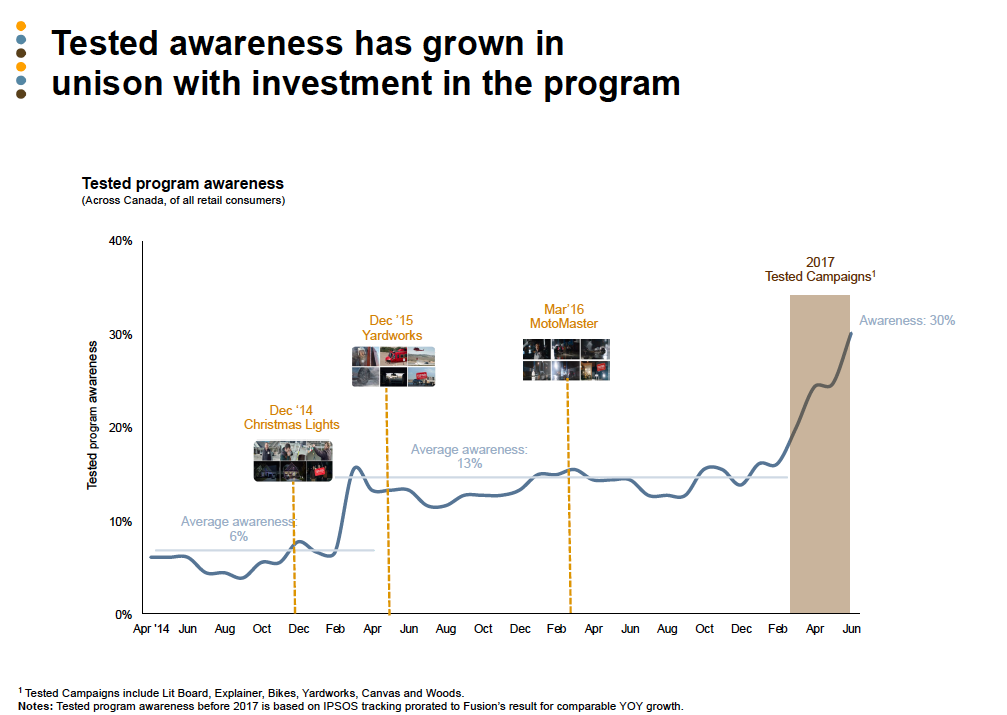
Difference in tracking between those aware of Tested and those unaware has resulted in the following gains, as reported by an August 2017 Hotspex study. Among those aware:
All indicated in the chart below, taken together these metrics account for a 48% more positive impression of Canadian Tire.
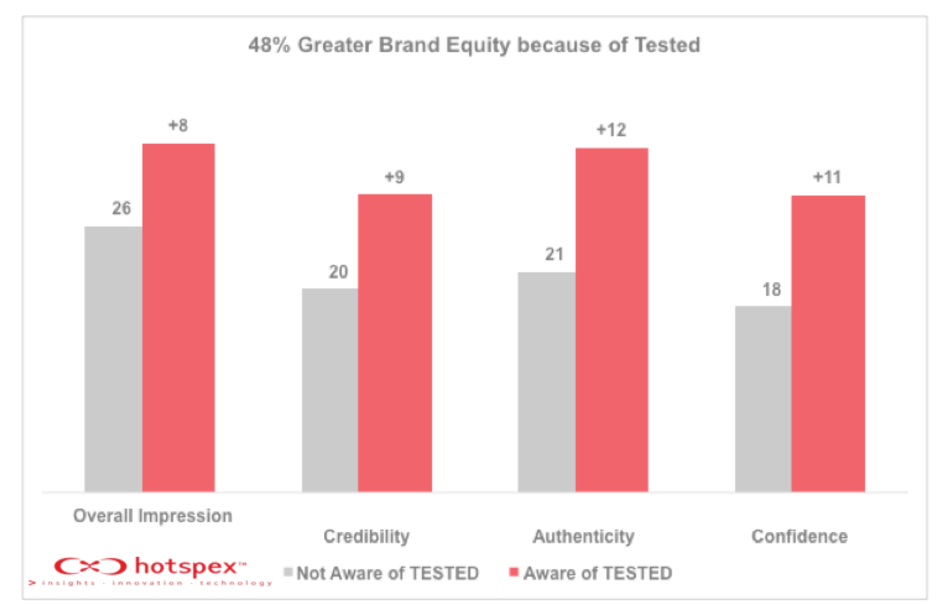
b) Prove the results were not driven by other factors
Campaign spend vs. history and competition:
Within the organization:
If Tested were merely an advertising idea, we’d want to demonstrate factors beyond communications were not responsible for results, but Tested is more than that. It’s an initiative that has permeated virtually every aspect of the organization. It’s at the heart of product development. It’s a coast-to-coast testing panel of over 15,000 Canadians. It drives flyer content, web strategy, relationships with suppliers throughout the world, and yes, advertising. Rather than other aspects of the business driving the results of Tested, Tested is a significant driver of the most important aspects of the organization.
Retail landscape:
Total retail sales in Canada in the last five years have been in the low single digits, whereas sales of Tested products are considerably higher, demonstrating momentum does not come from larger trends.

The organization’s commitment to Tested because of the business impact it has created is evident in its 2016 Annual Report. Along with business assets on the order of magnitude of its Loyalty Program, its Dealer Network and its Global Supply Chain, Tested for Life in Canada is recognized as one of the organization’s core capabilities.
Pre-existing Brand momentum:
NA
Pricing:
NA
Changes in Distribution/Availability:
NA
Unusual Promotional Activity:
NA
Any other factors:
NA